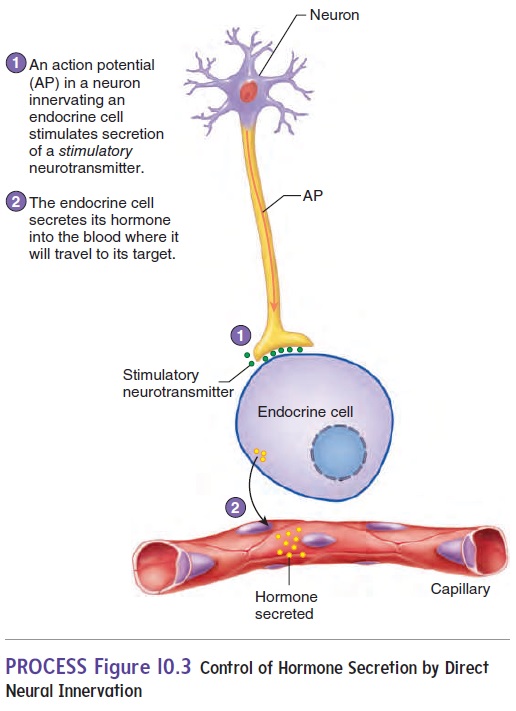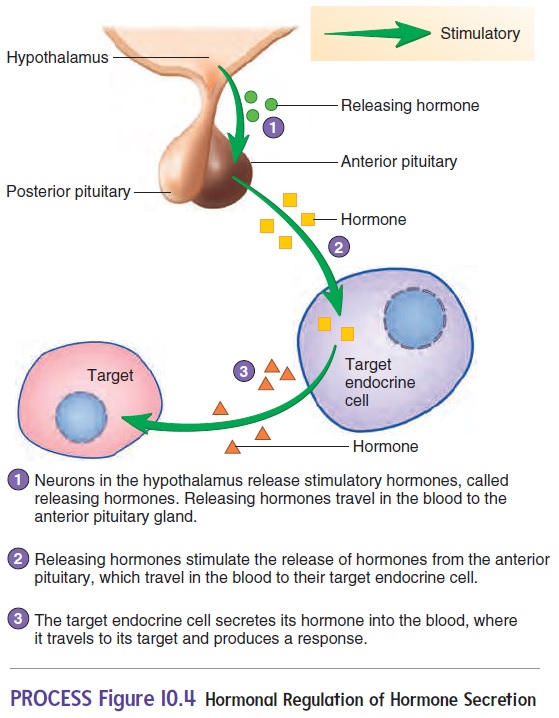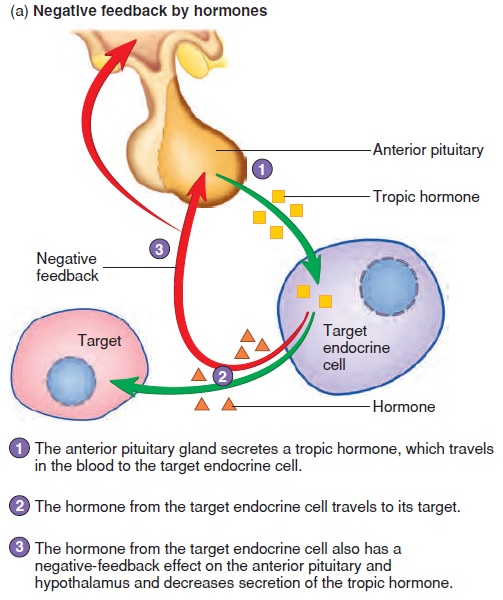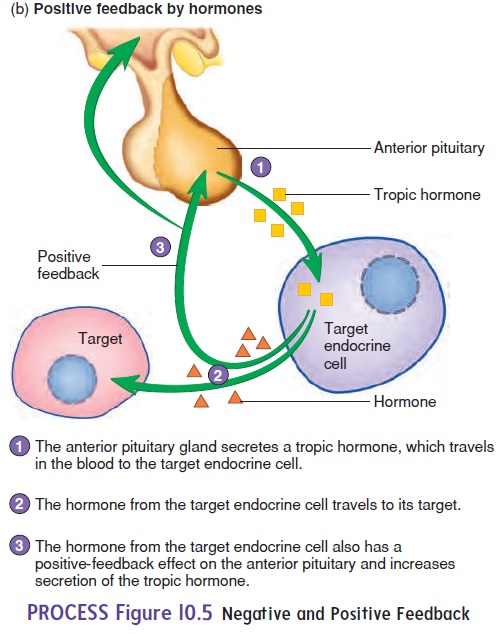Chapter: Essentials of Anatomy and Physiology: Endocrine System
Control of Hormone Secretion
CONTROL OF HORMONE SECRETION
A. List and describe the three stimulatory influences on hormone secretion and give examples of each.
B. List and describe the three inhibitory influences on hormone secretion and give examples of each.
C. Describe the major mechanisms that maintain blood hormone levels.
Three types of stimuli regulate hormone release: humoral, neural, and hormonal. No matter what stimulus releases the hormone, however, the blood level of most hormones fluctuates within a homeostatic range through negative-feedback mechanisms . In a few instances, positive-feedback systems also regulate blood hormone levels.
Stimulation of hormone release
Control by Humoral Stimuli
Blood-borne chemicals can directly stimulate the release of some hormones. These chemicals are referred to as humoral stimuli because they circulate in the blood, and the word humoral refers to body fluids, including blood. These hormones are sensitive to the blood levels of a particular substance, such as glucose, calcium, or sodium. Figure 10.2 illustrates that when the blood level of a par-ticular chemical changes (calcium), the hormone (PTH) is released in response to the chemical’s concentration. As another example, if a runner has just finished a long race during hot weather, he may not produce urine for up to 12 hours after the race because his elevated concentration of blood solutes stimulates the release of a water-conservation hormone called antidiuretic hormone (ADH). Similarly, elevated blood glucose levels directly stimulate insulin secretion by the pancreas, and elevated blood potassium levels directly stimulate aldosterone release by the adrenal cortex.

Figure 10.2 Humoral Regulation of Hormone Secretion
Control by Neural Stimuli
The second type of hormone regulation involves neural stimuli of endocrine glands. Following action potentials, neurons release a neurotransmitter into the synapse with the cells that produce the

In some cases, the neurotransmitter stimulates the cells to increase hormone secretion. Figure 10.3 illustrates the neural control of hormone secretion from cells of an endocrine gland. For example, in response to stimuli, such as stress or exercise, the sympathetic divi-sion of the autonomic nervous system stimulates the adrenal gland to secrete epinephrine and norepinephrine, which help the body respond to the stimulus. Responses include an elevated heart rate and increased blood flow through the exercising muscles. When the stimulus is no longer present, the neural stimulation declines and the secretion of epinephrine and norepinephrine decreases.
Some neurons secrete chemical messengers directly into the blood when they are stimulated, making these chemical messengers hormones, which are called neuropeptides. Specialized neuropeptides stimulate hormone secretion from other endocrine cells and are called releasing hormones, a term usually reserved for hormones from the hypothalamus.
Control by Hormonal Stimuli
The third type of regulation uses hormonal stimuli. It occurs when a hormone is secreted that, in turn, stimulates the secretion of other hor-mones (figure 10.4). The most common examples are hormones from the anterior pituitary gland, called tropic hormones. Many tropic hormones are part of a complex process in which a releasing hormone from the hypothalamus stimulates the release of a tropic hormone from the pituitary gland. The pituitary tropic hormone then travels to a third endocrine gland and stimulates the release of a third hormone. For example, hormones from the hypothalamus and anterior pituitary regulate the secretion of thyroid hormones from the thyroid gland

Inhibition Of Hormone Release
Stimulating hormone secretion is important, but inhibiting hormone release is also important. This process involves the same three types of stimuli: humoral, neural, and hormonal
Inhibition of Hormone Release by Humoral Stimuli
Often when a hormone’s release is sensitive to the presence of a humoral stimulus, there exists a companion hormone whose release is inhibited by the same humoral stimulus. Usually, the companion hormone’s effects oppose those of the secreted hormone and coun-teract the secreted hormone’s action.
For example, to raise blood pressure, the adrenal cortex secretes the hormone aldosterone in response to low blood pressure. However, if blood pressure goes up, the atria of the heart secrete the hormone atrial natriuretic peptide (ANP), which lowers blood pressure. Therefore, aldosterone and ANP work together to maintain homeostasis of blood pressure.
Inhibition of Hormone Release by Neural Stimuli
Neurons inhibit targets just as often as they stimulate targets. If the neurotransmitter is inhibitory, the target endocrine gland does not secrete its hormone.
Inhibition of Hormone Release by Hormonal Stimuli
Some hormones prevent the secretion of other hormones, which is a common mode of hormone regulation. For example, hormones from the hypothalamus that prevent the secretion of tropic hor-mones from the pituitary gland are called inhibiting hormones. Thyroid hormones can control their own blood levels by inhibiting their pituitary tropic hormone. Without the original stimulus, less thyroid hormone is released.
Regulation Of Hormone Levels In The Blood
Two major mechanisms maintain hormone levels in the blood within a homeostatic range: negative feedback and positive feed-back .
1. Negative feedback. Most hormones are regulated by a negative-feedback mechanism, whereby the hormone’s secretion is inhibited by the hormone itself once blood levels have reached a certain point and there is adequate hormone to activate the target cell. The hormone may inhibit the action of other, stimulatory hormones to prevent the secretion ofthe hormone in question. Thus, it is a self-limiting system(figure 10.5a). For example, thyroid hormones inhibit thesecretion of their releasing hormone from the hypothalamusand their tropic hormone from the anterior pituitary.


2. Positive feedback. Some hormones, when stimulated bya tropic hormone, promote the synthesis and secretionof the tropic hormone in addition to stimulating theirtarget cell. In turn, this stimulates further secretion of theoriginal hormone. Thus, it is a self-propagating system(figure 10.5b). For example, prolonged estrogen stimulationpromotes a release of the anterior pituitary hormoneresponsible for stimulating ovulation.
Related Topics